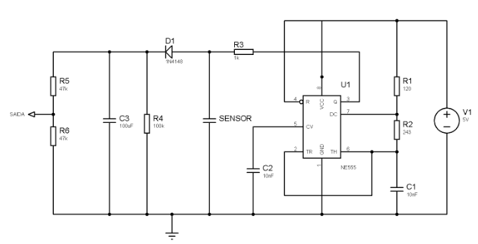I have built a grain moisture sensor using a 555 timer and an arduino, as shown in the figure:
The sensor is composed of a two parallel aluminum plates (as in a capacitor):
 The output of this circuit is connected to analog arduino pin A0. I have noticed that the higher the moisture of the grain, the lower is the voltage read by the analog pin. From basic phyisics:
The output of this circuit is connected to analog arduino pin A0. I have noticed that the higher the moisture of the grain, the lower is the voltage read by the analog pin. From basic phyisics:
\$ C =(ε_0 ε_R A)/d\$ - in which \$ ε_R\$ is the dielectric of the capacitor, so the higher the moisture the higher the capacitance of the sensor is.
I am having trouble understanding why voltage drops when moisture is higher. Why does the voltage drop when the moisture is higher?

